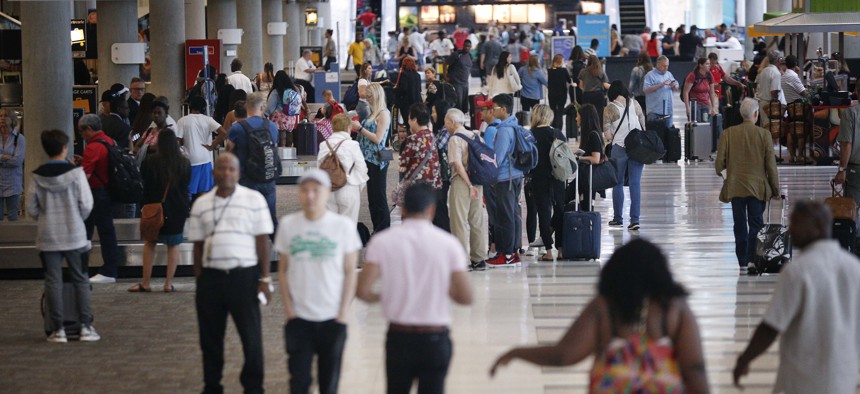U.S. Population Growing Very Slowly, Census Bureau Says

Travelers gather their belongings at baggage claim at the Fort Lauderdale–Hollywood International Airport on Friday, June 29, 2018, in Fort Lauderdale, Fla. AP Photo/Brynn Anderson
Ten states lost residents in 2019. But despite the country’s population gains slowing to a crawl, some states are attracting more residents, with Idaho and Nevada growing fastest.
New York lost more residents than any other state in the country, but West Virginia lost the biggest percentage of its population in 2019, according to Census Bureau data released this week.
The U.S. population grew by about 1.5 million people between 2018 and 2019, but the country’s growth is slowing with births on the decline in 42 states, according to the new data from the bureau.
More than 3.9 million people were born in the United States and 2.8 million people died, resulting in a natural population increase of 956,674 people. It’s the first time in decades that the nation’s natural growth was less than 1 million people, according to Census officials.
In a Brookings Institution report using the Census data, William Frey, a senior fellow, projected that the last decade will end up with the slowest population growth for any 10-year period in U.S. history. He noted that this reflects an aging population, with fewer young people under 18.
“The 2010s was a decade of fewer births, more deaths, and uneven immigration,” he wrote.
International migration to the United States, which has been on the decline since 2017, also grew the U.S. population by about 600,000 people.
The state that saw the largest percent decrease in population was West Virginia, which lost .7% of its population. Approximately 22,500 people died, 17,800 people were born, and 7,400 people moved out of West Virginia, leading to a net loss of about 12,100 residents. The state, dubbed ground zero for the opioid epidemic, leads the nation in opioid-related overdose deaths.
The state was one of four that saw more deaths than births in 2019. Deaths also outpaced births in Maine, New Hampshire and Vermont. A total of 24 states reported an increase in deaths from 2018 to 2019.
Domestic migration also contributed significantly to population decreases in some states in 2019. The states that saw the greatest number of people move away were California, New York and Illinois, which each lost more than 100,000 residents.
Donald Trump was among those who left New York in 2019, with the president and first lady filing to change their official residence to Palm Beach, Florida where the Mar-a-Lago resort is located.
Combined with births and deaths, New York lost more residents than any other state, with a net population decrease of about 76,700 people.
About half of registered voters in California have considered leaving the state, according to a recent poll by the University of California, Berkeley. Voters said the biggest driver behind their consideration was the high cost of housing in the state, followed by high taxes and California’s political culture. On the other hand, 50% of California residents in the same poll described the state as “one of the best places to live.”Despite the decline in births and shifting migration patterns, 40 states and the District of Columbia saw population increases between 2018 and 2019.
Idaho, where the population grew by 2.1%, had the greatest percentage increase in population. More than 27,000 people moved to the state from elsewhere—so many coming from California, in fact, that some locals describe feeling resentful of the newcomers.
Nevada, Arizona and Utah tied for the next greatest percentage increase in population, with each state experiencing 1.7% growth in population over the last year.
Andrea Noble is a staff correspondent with Route Fifty.
NEXT STORY: Tariffs Drove Manufacturing Job Losses, Fed Report Says





